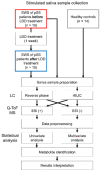Low-Dose Doxycycline Treatment Normalizes Levels of Some Salivary Metabolites Associated with Oral Microbiota in Patients with Primary Sjögren's Syndrome
- PMID: 34564411
- PMCID: PMC8470364
- DOI: 10.3390/metabo11090595
Low-Dose Doxycycline Treatment Normalizes Levels of Some Salivary Metabolites Associated with Oral Microbiota in Patients with Primary Sjögren's Syndrome
Abstract
Saliva is a complex oral fluid, and plays a major role in oral health. Primary Sjögren's syndrome (pSS), as an autoimmune disease that typically causes hyposalivation. In the present study, salivary metabolites were studied from stimulated saliva samples (n = 15) of female patients with pSS in a group treated with low-dose doxycycline (LDD), saliva samples (n = 10) of non-treated female patients with pSS, and saliva samples (n = 14) of healthy age-matched females as controls. Saliva samples were analyzed with liquid chromatography mass spectrometry (LC-MS) based on the non-targeted metabolomics method. The saliva metabolite profile differed between pSS patients and the healthy control (HC). In the pSS patients, the LDD treatment normalized saliva levels of several metabolites, including tyrosine glutamine dipeptide, phenylalanine isoleucine dipeptide, valine leucine dipeptide, phenylalanine, pantothenic acid (vitamin B5), urocanic acid, and salivary lipid cholesteryl palmitic acid (CE 16:0), to levels seen in the saliva samples of the HC. In conclusion, the data showed that pSS is associated with an altered saliva metabolite profile compared to the HC and that the LLD treatment normalized levels of several metabolites associated with dysbiosis of oral microbiota in pSS patients. The role of the saliva metabolome in pSS pathology needs to be further studied to clarify if saliva metabolite levels can be used to predict or monitor the progress and treatment of pSS.
Keywords: Sjögren’s syndrome; doxycycline; hyposalivation; metabolomics; saliva.
Conflict of interest statement
O.K. and K.H. are founders of Afekta Technologies Ltd., a company providing metabolomics analysis services. The other authors have no potential conflict of interest to declare.
Figures



Similar articles
-
Metabolomics analysis of saliva from patients with primary Sjögren's syndrome.Clin Exp Immunol. 2015 Nov;182(2):149-53. doi: 10.1111/cei.12683. Epub 2015 Sep 15. Clin Exp Immunol. 2015. PMID: 26201380 Free PMC article.
-
Altered O-Glycans in stimulated whole saliva from patients with primary Sjögren's syndrome and non-pSS sicca.Sci Rep. 2024 Nov 26;14(1):29377. doi: 10.1038/s41598-024-79473-1. Sci Rep. 2024. PMID: 39592783 Free PMC article.
-
Association of salivary inflammatory biomarkers with primary Sjögren's syndrome.J Oral Pathol Med. 2020 Oct;49(9):940-947. doi: 10.1111/jop.13070. Epub 2020 Jul 2. J Oral Pathol Med. 2020. PMID: 32538490
-
Healthy Patients Are Not the Best Controls for Microbiome-Based Clinical Studies: Example of Sjögren's Syndrome in a Systematic Review.Front Immunol. 2021 Jul 29;12:699011. doi: 10.3389/fimmu.2021.699011. eCollection 2021. Front Immunol. 2021. PMID: 34394092 Free PMC article.
-
The Proteomics of Saliva in Sjögren's Syndrome.Rheum Dis Clin North Am. 2016 Aug;42(3):449-56. doi: 10.1016/j.rdc.2016.03.004. Epub 2016 Jun 21. Rheum Dis Clin North Am. 2016. PMID: 27431347 Free PMC article. Review.
Cited by
-
Characteristics of gut microbiota in patients with primary Sjögren's syndrome in Northern China.PLoS One. 2022 Nov 10;17(11):e0277270. doi: 10.1371/journal.pone.0277270. eCollection 2022. PLoS One. 2022. PMID: 36355832 Free PMC article.
-
Updates and Original Case Studies Focused on the NMR-Linked Metabolomics Analysis of Human Oral Fluids Part III: Implementations for the Diagnosis of Non-Cancerous Disorders, Both Oral and Systemic.Metabolites. 2023 Jan 1;13(1):66. doi: 10.3390/metabo13010066. Metabolites. 2023. PMID: 36676991 Free PMC article.
-
Lipid Metabolism: An Emerging Player in Sjögren's Syndrome.Clin Rev Allergy Immunol. 2025 Feb 11;68(1):15. doi: 10.1007/s12016-025-09023-8. Clin Rev Allergy Immunol. 2025. PMID: 39934534 Free PMC article. Review.
-
Application of omics in Sjögren's syndrome.Inflamm Res. 2023 Dec;72(12):2089-2109. doi: 10.1007/s00011-023-01797-x. Epub 2023 Oct 25. Inflamm Res. 2023. PMID: 37878024 Review.
-
Critical Factors in Sample Collection and Preparation for Clinical Metabolomics of Underexplored Biological Specimens.Metabolites. 2024 Jan 5;14(1):36. doi: 10.3390/metabo14010036. Metabolites. 2024. PMID: 38248839 Free PMC article. Review.
References
-
- Wong D. Salivary Diagnostics. Wiley-Blackwell; Ames, IA, USA: 2008. pp. 27–29.
-
- Cecchettini A., Finamore F., Ucciferri N., Donati V., Mattii L., Polizzi E., Ferro F., Sernissi F., Mosca M., Bombardieri S., et al. Phenotyping multiple subsets in Sjögren’s syndrome: A salivary proteomic SWATH-MS approach towards precision medicine. Clin. Proteom. 2019;16:26. doi: 10.1186/s12014-019-9245-1. - DOI - PMC - PubMed
-
- Zoukhri D., Rawe I., Singh M., Brown A., Kublin C.L., Dawson K., Haddon W.F., White E.L., Hanley K.M., Tusé D., et al. Discovery of putative salivary biomarkers for Sjögren’s syndrome using high resolution mass spectrometry and bioinformatics. J. Oral Sci. 2012;54:61–70. doi: 10.2334/josnusd.54.61. - DOI - PMC - PubMed
-
- Hauck T.S., Douglas S.C., Bookman A. Sjogren’s syndrome in Canada: Diagnosis, treatment and patient perspectives. Connections. 2013;7
Grants and funding
LinkOut - more resources
Full Text Sources

